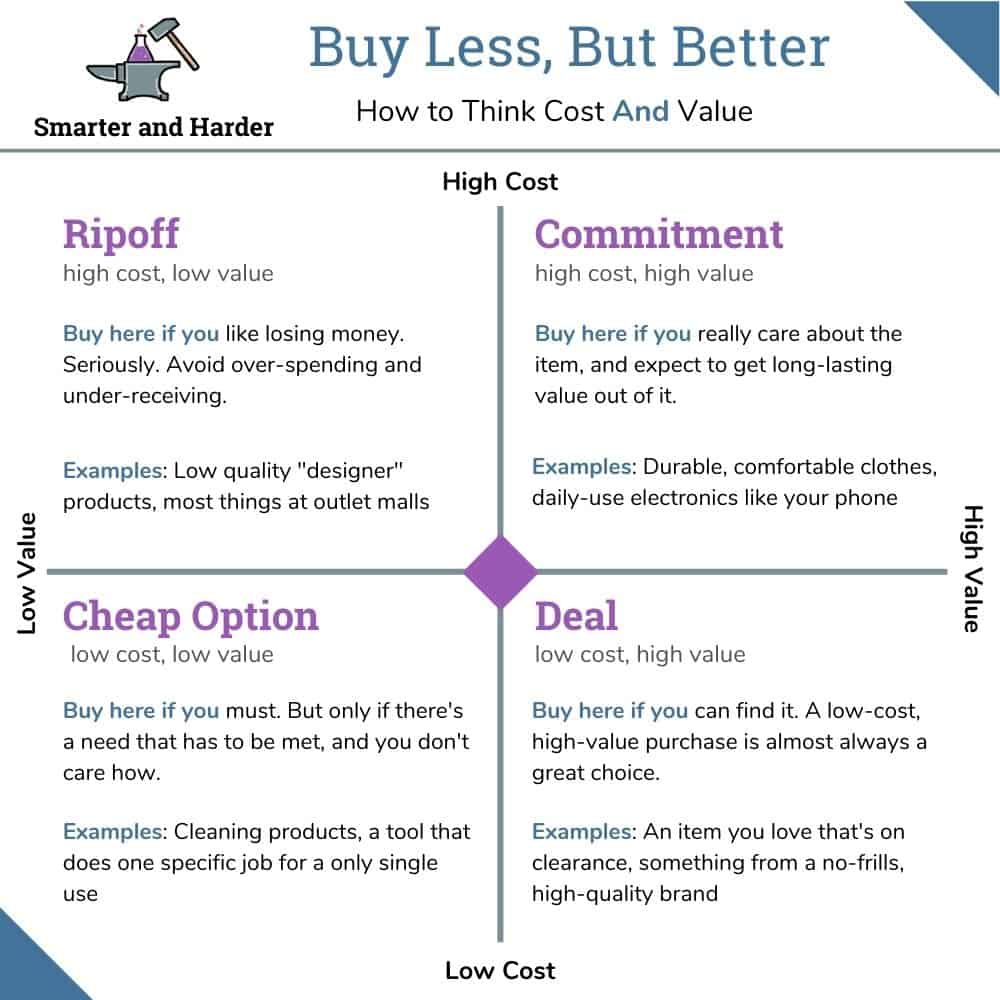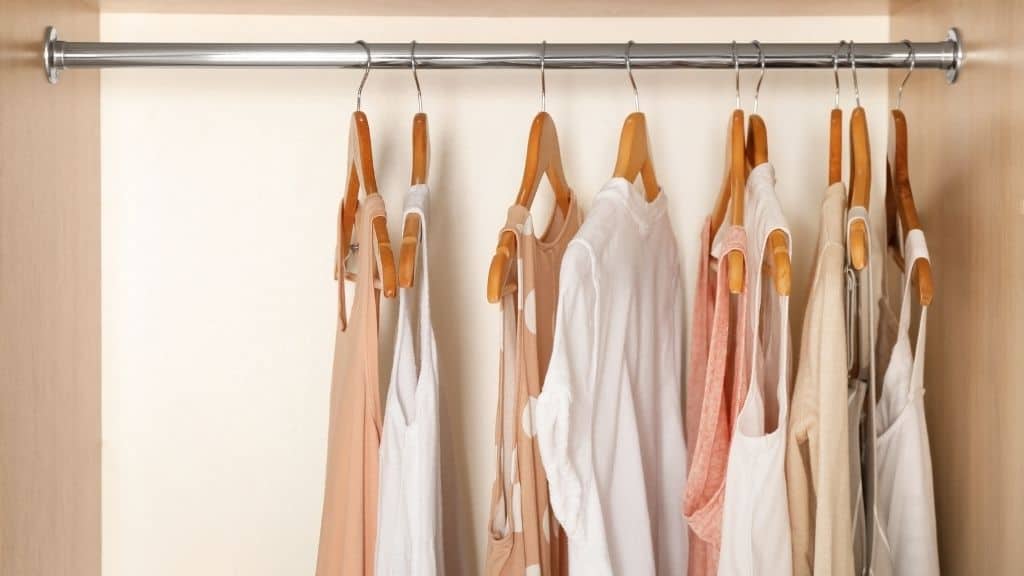Are you doing everything you can to save money? Are you sticking to a budget, hunting for the best deals, and always getting the lowest price?
Well, hold on there for a second.
A wholesale approach to saving money this way could actually cost you more over the long term. It may also be causing needless discomfort in the process. For a frugal lifestyle that is both sustainable and enjoyable, we all ought to consider buying less but better.
Frugal Doesn’t Mean Cheap
If I told you that I’m enthusiastically frugal, you could probably gather a few bits of info about me right away:
- I’ve never owned a pair of jeans that cost more than $20.
- I eat steamed rice and beans for most of my meals because it is highly cost-efficient.
- On the rare occasion that someone drags me to a restaurant, I refuse to buy appetizers because they are a scam.
- Due to a rare coupon-stacking oversight at my local grocery store, it was possible for one week in 2009 to buy hand soap for 20 cents a bar, so I bought two pallets of it.
The only problem is that none of these things is even remotely true. Can you imagine living like this? It would be exhausting. Appetizers are why I go to restaurants.
Stereotypes like this give many people entirely the wrong idea of what it means to live frugally. This baggage holds us all back in two ways:
- It teaches us to associate being frugal with grumpy cheapskates who never have any fun when we could see it as a tremendous force for good.
- It makes us think that this kind of penny-pinching is the best way to save a lot of money, which it isn’t.
Fortunately for us, but unfortunately for the rice and beans industry (don’t worry, they’ll be fine), this notion is way off. Saving money doesn’t always mean buying cheap. It means buying less but better.
Cost vs. Value
The biggest misconception about frugality is that it only concerns the cost of things. In reality, two factors go into wise spending decisions. If we want to save more money today and over the long term, we need to weigh the value of the purchase, not just the price tag.
Cost (or price) is the money you put into something. Value is what that thing is worth to you.
“Price is what you pay. Value is what you get.”
Warren Buffett
While cost is usually an exact number with a dollar sign in front of it, value is somewhat subjective. A variety of factors determine a product or service’s value, such as:
- How effectively it does its job
- How long it is likely to last before needing repair, replacement, or follow-up
- Not insignificantly, how it makes you feel and how much you enjoy it
Let’s look at how combining these two factors can significantly impact your spending decisions.
Maximizing Value Per Cost
Let’s say you want to save money on sneakers. There is one pair that costs $50 and another that costs $80. The simple choice is to take the lower price tag, and boom, you’ve saved $30.
But what happens when you bring value into the mix?
What if the $50 pair is from a low-quality brand that will quickly start to fall apart, and the $80 option is from a brand you trust to be comfortable and hold up for at least a few years? If you buy the “cheaper” pair, but you like wearing them half as much and need to replace them twice as often, did you really get the better deal?
Spending as little money as possible upfront feels like you’re being thrifty, but it often drives you to buy more over time to supplement or replace low-quality products.
In this example, the pair of shoes with the higher initial price tag not only cost less money over time but was also a more enjoyable product to own. When you put cost alone above all else when making purchasing decisions, you may miss out on both these opportunities.
How to Buy Less but Better (Examples)
So if low-cost, low-value is a waste of money, does that mean we should always aim for high-cost, high-value products and services?
Not necessarily.
The sneakers example above shows why it is essential to decouple the ideas of cost and value. It is easier to stick to your money goals when you look at both. However, this does not mean that low-cost purchases are always the problem.
You can easily waste as much money on a high-cost purchase as a low-cost one if the price is all you consider.

Many things you buy don’t need to last you for years or be of paramount quality. These things have a job to do and are not worth any more money than you need to spend for them. On the other hand, something you expect to use heavily, or that will show up regularly in your day-to-day life, is worth prioritizing higher value, even if a higher cost accompanies it.
Consider some of the below examples and money-saving tips to help you get off the hedonic treadmill and start practicing frugal luxury.
Groceries
Store-brand products are often the butt of the joke regarding disappointing ways to save money on groceries. We see examples in pop culture that generic products like these are only for financially struggling families who can’t afford the “good stuff.”
But when you drill down, whether or not to save money with generic groceries is an excellent microcosm of the “buy less but better” mindset.
There are many products where the cheapest option available is all you need, and there is no discernible change in value by spending more on them. For me, these include:
- Rice and dry pasta
- Milk and eggs
- Most cleaning products
- Over-the-counter medicines
At the same time, there are plenty of products in the grocery store for which a higher value justifies a bit of a splurge. Some of mine are:
- Ice cream
- Cheeses
- Bread
- Trash bags
There are many personal preferences at play here, and yours may not be the same as mine. Remember, value is highly subjective. Understanding what matters most to you (and which products offer it) can go a long way to helping you maximize value while cutting down on prices at the supermarket.
Clothing
The fast fashion industry has made it incredibly easy to have a constantly evolving wardrobe for seemingly crazy-low prices. Unfortunately, these low costs add up over time as many products are not designed to last very long. As a result, most cheap clothing demands frequent replacement, whether due to low-quality materials and construction or the rapid burnout of a fleeting trend.
There is risk on the higher end of clothes pricing too. Countless products align themselves under the banner of luxury brands to charge several orders of magnitude more for similar quality to a much cheaper item.
Fortunately, there is a sweet spot. Keep a few of these frugal tips in mind when searching for low-spend, high-quality clothing:
- Be mindful of classic styles vs. passing trends
- Look for brands that emphasize “quality” rather than “luxury”
- Watch out for certain “mall brands” that offer trendy styles at a bargain
- Be patient in seeking out items that you genuinely love
- Try thrift shopping to search for high-quality products at insanely low cost
- Consider a capsule wardrobe to maximize satisfaction with your outfit options
Clothing is an area that can take a person all over the four quadrants of cost and value shown above. Yet, with patience and the right mindset, you can consistently bring home clothes you love that will last you for years and still save you money in the long run.
Electronics
The manufacturing and production of electronics have scaled up exponentially over the last 40 years. This progression, combined with online distribution, has made it easier than ever for companies of all sizes to offer consumers a massive variety of low-cost electronics.
While this trend is sometimes good for consumers’ finances, it has also given rise to an untold number of manufacturers shuffling out products of such low quality that they often come dead on arrival.
The good news is that electronics might be one of the easiest places to make savvy spending decisions, as it usually comes down to common sense. Here are a few things to keep in mind:
- Be wary, even more so than with most products, of brand names you do not recognize.
- Watch out for price gaps that are too large to make sense. If a household brand sells a product for $40, and someone else has a similar-looking item for $4, that is a red flag.
- Is the product description or sales page well-written and easy to understand? Low-quality marketing is not necessarily a problem but can often highlight a company with no qualms about cutting corners.
Buy It for Life (BIFL)
It’s usually not fun to pass up what sounds like a crazy-good deal for a more expensive option. However, you’ll always thank yourself later for buying a product that does its job well and still works two weeks (not to mention two years) after you buy it.
For one final mindset tip on frugal luxury, let’s talk about the concept of “buy it for life,” or BIFL.
A “buy it for life” product or brand is one that maintains its quality and still does its main function well after many years or decades. While an item doesn’t necessarily need to literally last a lifetime to qualify, many do just that. Some even last multiple generations and can become family heirlooms of a sort.
Companies that sell buy it for life products also often pride themselves on excellent customer service and far-reaching warranties on their products.
The reddit buy it for life community is a great place to browse for great BIFL product ideas, but here are a few of my personal favorites:
- Leatherman multi-tools
- MagLite flashlights
- Almost anything from L.L. Bean or Patagonia
- Darn Tough socks
- Rainbow Sandals
- Lodge cast iron cookware
- Of course, the holy grail of BIFL: the KitchenAid stand mixer
Remember, the goal of living frugally is not to reduce one-time costs, but to reduce the amount you spend overall. BIFL products are one of the cleanest and most effective ways to do that.
Living Frugally, in Style
You don’t have to be a cheapskate to practice frugal living and save on countless expenses each month. Usually, the secret to frugal luxury is spending money intentionally on things that make sense while learning to cut back on spending that doesn’t make your life better. But, as always, personal finance is mostly personal, so only you can decide what you value most and where it’s better to hold onto your pennies.


HAHA love that. Appetizers is also the reason I go to restaurants! This is an awesome post, Sam! I live similarly. I live intentionally which means my purchases are thought out, budgeted and planned. My home isn’t fully furnished yet after a year of living in it because I haven’t found things that I’ve absolutely loved yet but I’m willing to wait and this means raising my budget too! Thanks for sharing 🙂
Lynn | https://www.lynnmumbingmejia.com
Haha same! My first apartment after college stayed largely empty the first year or so while I picked out furniture I loved. No need to rush to fill it up just for it to be filled up!
I used to buy so many clothes. Most purchases were impulse buys, usually if the item was in the sale. I would fall out of love with these clothing items within weeks. In the long run it ended up costing me a small fortune!
Nowadays, I only buy pieces that are good quality, and that I truly love – and these purchases are rare. Thanks for this post 🙂
I think clothes are a great example, I hear this one a lot from people on this topic. You can overspend on clothes, and you can underspend on clothes. But if you’re thoughtful and patient, you can always find pieces that will really stand out, make you feel great, and that will last for ages.
Clothes are a prime example for many. Consumerism can become a terrible addiction – stressful, bad for the environment and, of course, the bank balance! The psychology behind it is wild. So happy to have kicked the habit. Thanks, Sam 🙂
Such a good post! I think I’m also guilty of buying cheap clothes which obviously don’t wear that well. I have to say spending more money on quality basic/timeless pieces is something I try to do and if i want to buy something more trendy I usually buy a more affordable option.
xoxo Annaleid
http://www.actuallyanna.com
I love that approach, and I’ve heard a few others mention it. Go for high value on the classics and timeless items, and focus on low cost for something trendy/short term. Makes a lot of sense!
this is a really great post with some great tips, I personally tend to buy way too much cheap stuff, particularly clothes as it’s just become a habit, but I’m intending to cut down on the amount that I purchase in order to help with sustainability as well as value for money.
that’s great! sustainability is an important point to this that I didn’t even really get into, but reducing our overall consumption has a huge impact on our little world, not just our own lives.